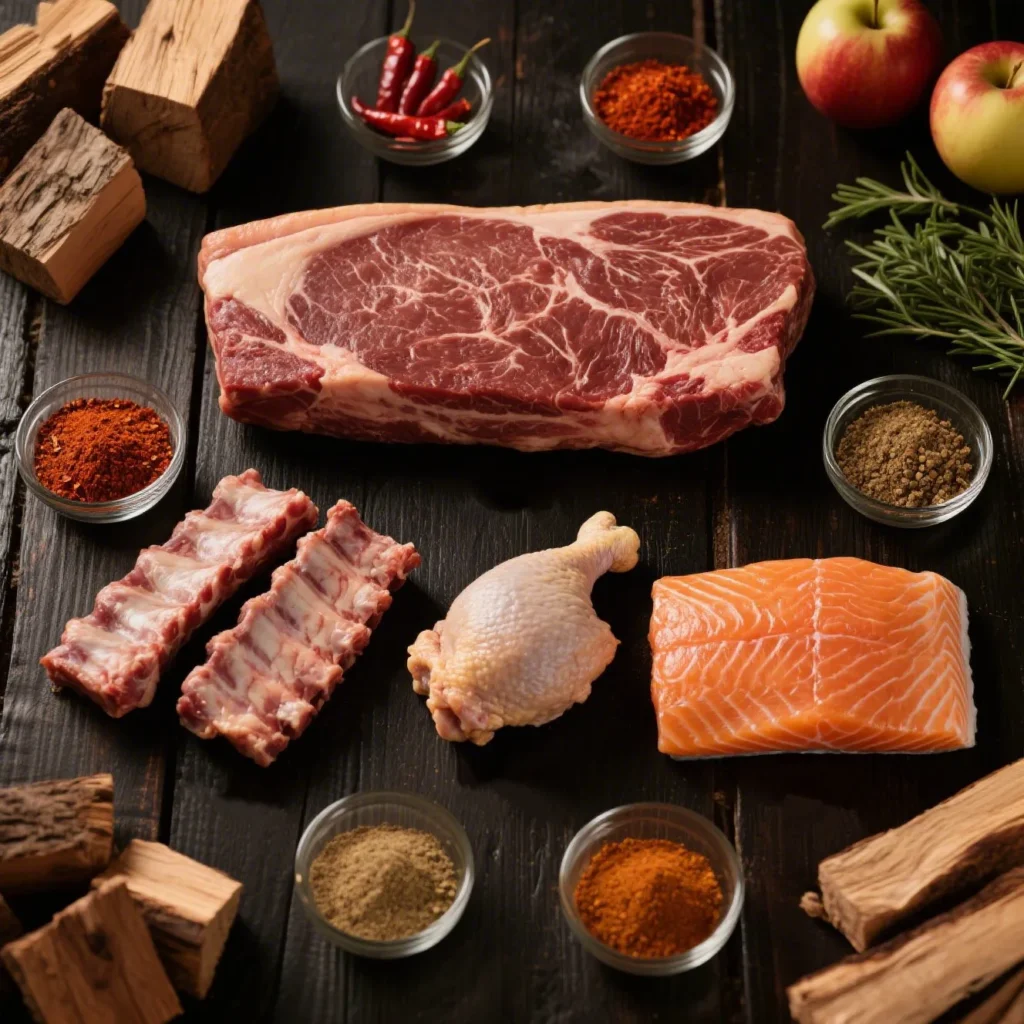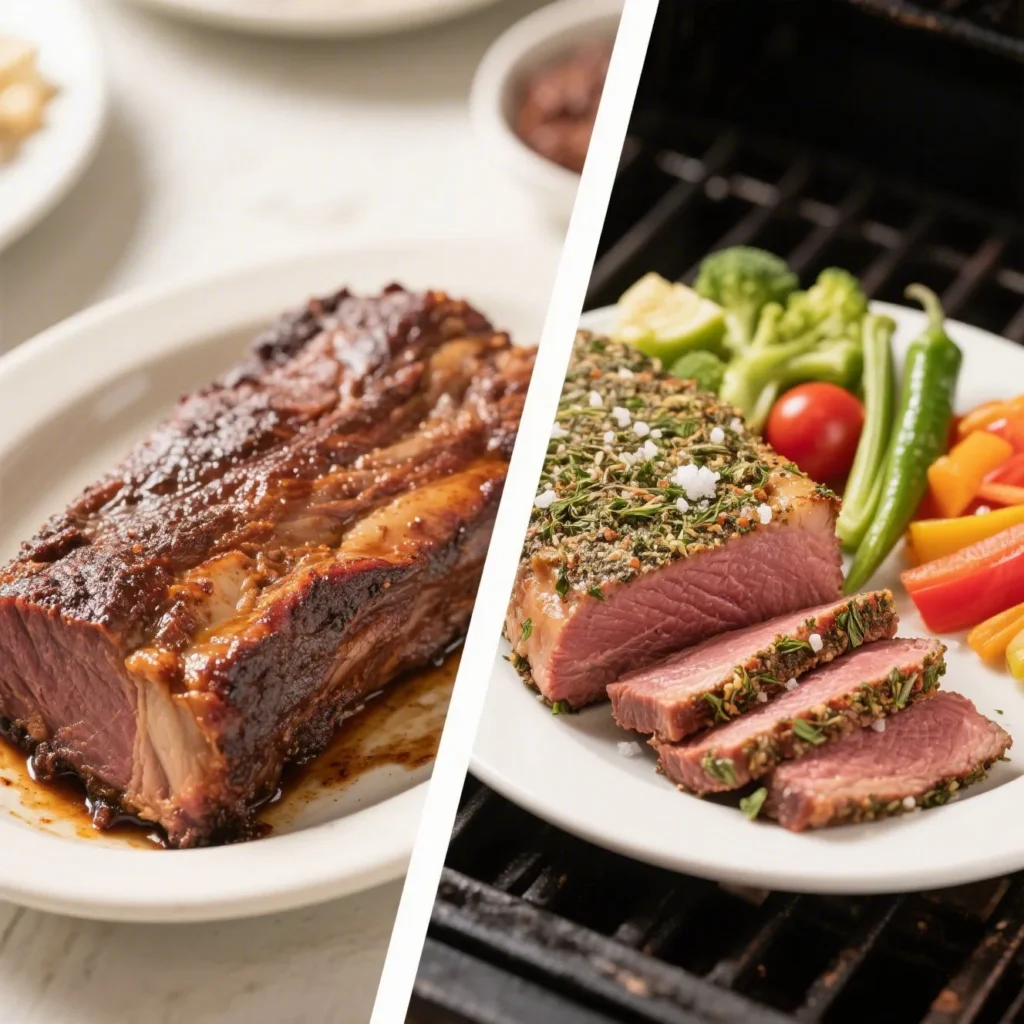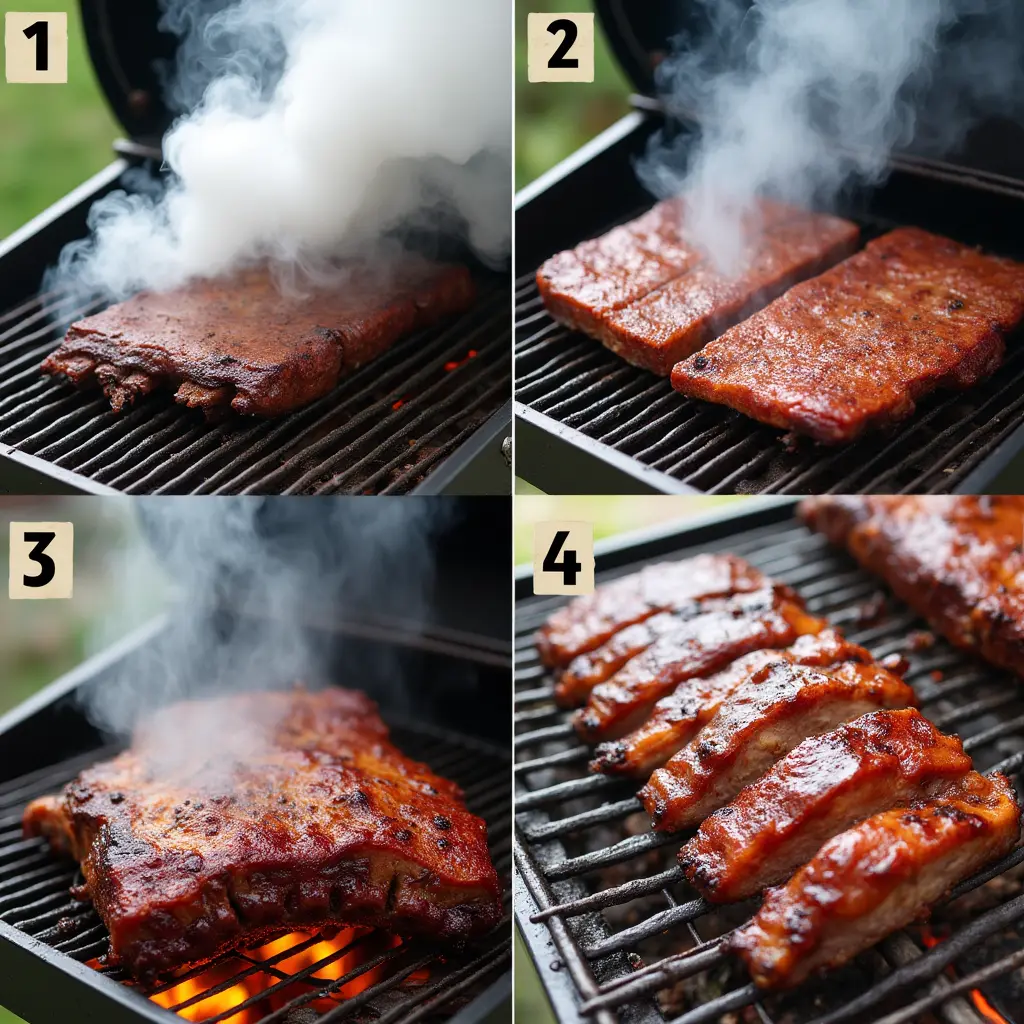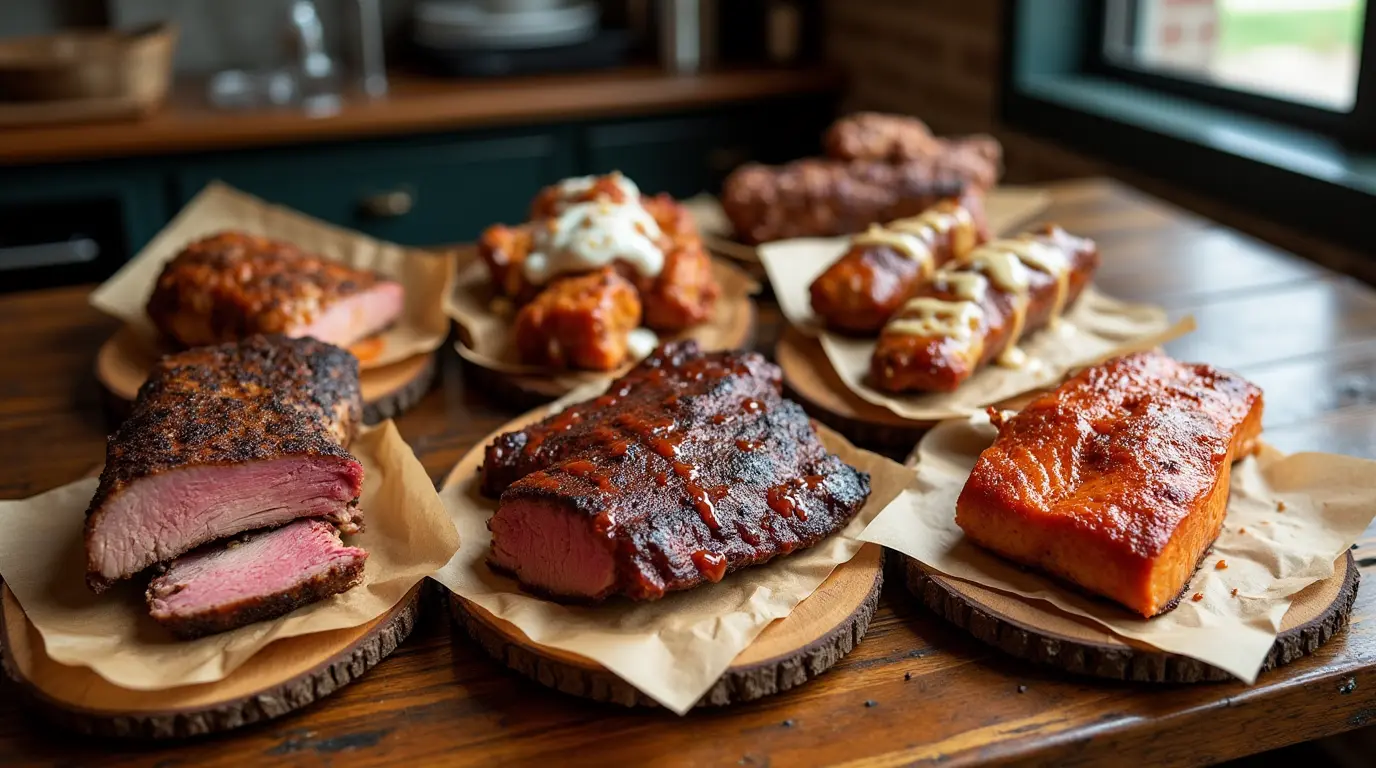Did you know that 78% of home barbecue enthusiasts fail their first attempt at smoking meat, despite Americans consuming over 9.8 billion pounds of smoked meats annually? The precise balance of temperature, timing, and technique in smoked meat recipes creates a culinary challenge that separates amateur grillers from true pitmasters. Whether you’re a backyard enthusiast or an aspiring chef, mastering these six regional smoked meat recipes will elevate your cooking repertoire with authentic flavors from America’s most celebrated barbecue traditions.
Table of Contents
Ingredients List
Texas-Style Beef Brisket
- A complete beef brisket weighing 10-12 pounds with both point and flat sections attached
- 1/4 cup kosher salt
- 1/4 cup coarse black pepper
- 2 tablespoons garlic powder
- 2 tablespoons onion powder
- Oak or mesquite wood chunks for smoking
Substitutions: For a leaner option, substitute with a 6-8 lb brisket flat. If kosher salt isn’t available, use sea salt at a 3:4 ratio.
Memphis Dry-Rub Ribs
- 2 racks St. Louis-style pork ribs (approximately 6 lbs)
- 2 tablespoons yellow mustard (as binder)
- 1/4 cup paprika
- 2 tablespoons brown sugar
- 2 tablespoons kosher salt
- 2 tablespoons black pepper
- 1 tablespoon garlic powder
- 1 tablespoon onion powder
- 1 tablespoon cayenne pepper (adjust to taste)
- 1 teaspoon dried thyme
- 1 teaspoon dried oregano
- Applewood or cherry wood chunks for smoking
Substitutions: Baby back ribs can be used with a 25% reduction in cooking time. For less heat, cut cayenne pepper in half.
Kansas City Burnt Ends
- 5-6 lb beef brisket point
- 1/4 cup brown sugar
- 2 tablespoons kosher salt
- 2 tablespoons black pepper
- 2 tablespoons paprika
- 1 tablespoon chili powder
- 1 tablespoon garlic powder
- 1 tablespoon onion powder
- 1 cup Kansas City-style barbecue sauce
- Hickory or oak wood chunks for smoking
Substitutions: Chuck roast can substitute for brisket point with similar texture but different fat distribution patterns.
Alabama Smoked Chicken with White Sauce
- 2 whole chickens (3-4 lbs each), spatchcocked
- 2 tablespoons olive oil
- 3 tablespoons kosher salt
- 2 tablespoons black pepper
- 2 tablespoons paprika
- 1 tablespoon garlic powder
- Pecan wood chunks for smoking
For Alabama White Sauce:
- 2 cups mayonnaise
- 1/2 cup apple cider vinegar
- 2 tablespoons black pepper
- 2 tablespoons fresh lemon juice
- 1 tablespoon horseradish
- 1 teaspoon kosher salt
- 1/2 teaspoon cayenne pepper
Substitutions: Turkey can replace chicken with a 40% increase in cooking time. Greek yogurt can substitute for half the mayonnaise for a tangier, lighter sauce.
Pacific Northwest Smoked Salmon
- 4-5 lb whole salmon fillet, skin on
- 1 cup kosher salt
- 1/2 cup brown sugar
- 2 tablespoons black pepper
- 1 tablespoon dried dill
- 1 tablespoon garlic powder
- Zest of 2 lemons
- Alder wood chunks for smoking

Alternative option: Single salmon portions can be used, though they demand careful temperature observation throughout cooking.Steelhead trout offers a comparable flavor profile with slightly less omega-3 fatty acids.
Timing
Each recipe requires careful timing for optimal results, with total process times ranging from 3 hours for salmon to 16+ hours for a proper Texas brisket. Preparation times average 30 minutes, while actual smoking times vary significantly based on the protein density and fat content.
| Recipe | Prep Time | Smoke Time | Rest Time | Total Time |
|---|---|---|---|---|
| Texas Brisket | 30 min | 12-14 hours | 2 hours | 14-16+ hours |
| Carolina Pulled Pork | 30 min | 10-12 hours | 1 hour | 11-13+ hours |
| Memphis Ribs | 45 min | 5-6 hours | 10 min | 6-7 hours |
| Kansas City Burnt Ends | 30 min | 8 hours (initial) + 2 hours (cubed) | 30 min | 10-11 hours |
| Alabama Chicken | 20 min | 2-3 hours | 15 min | 3-4 hours |
| Northwest Salmon | 20 min (+ 2 hours curing) | 1-2 hours | 10 min | 3-4 hours |
Remarkably, properly smoked meats spend 85-90% of their total preparation time in the smoking process itself, allowing the complex flavor compounds to develop fully—significantly longer than conventional cooking methods.
Step-by-Step Instructions
Step 1: Preparing Your Smoker
Start by preheating your smoker to the desired temperature prior to adding your meat. For most smoked meat recipes, you’ll aim for a stable temperature between 225°F and 275°F, depending on the specific cut. Allow 30-45 minutes for temperature stabilization, which ensures consistent cooking from the moment your meat enters the smoker. Research shows that temperature fluctuations greater than 15°F can increase cooking time by up to 25%.
For gas smokers: Preheat to desired temperature, add wood chips to the smoker box, and wait for thin blue smoke before adding meat.
For charcoal smokers: Light charcoal, arrange for indirect heat, add wood chunks when coals are white-hot, and adjust vents to reach target temperature.
For pellet smokers: Fill the hopper with appropriate wood pellets, set your desired temperature, and allow 15 minutes for the grill to reach stability.
Step 2: Preparing Your Meat
Proper meat preparation significantly impacts the final flavor profile. For each of our regional smoked meat recipes, follow these specific guidelines:
Texas Brisket: Trim the fat cap to 1/4 inch thickness. Apply salt and pepper generously, ensuring 100% coverage with approximately 1/2 teaspoon of rub per square inch of meat surface.
Carolina Pulled Pork: Apply mustard as a binding agent, then coat thoroughly with the dry rub mixture, massaging it into all surfaces. Let rest at room temperature for 30 minutes to allow the rub to adhere properly.
Memphis Ribs: Remove the membrane from the back of the ribs by sliding a butter knife under it and pulling with a paper towel. Apply mustard as a binder, then coat with dry rub, ensuring coverage in all crevices.
Prepare Kansas City Burnt Ends by removing excess fat from the brisket point, while maintaining a thin 1/4 inch layer for proper rendering during smoking.Apply rub liberally on all sides, using approximately 1 tablespoon of rub per pound of meat.
Alabama Chicken: Spatchcock the chicken by removing the backbone and flattening it. Rub with olive oil, then apply the dry rub mixture thoroughly, including under the skin for maximum flavor penetration.
Northwest Salmon: Mix cure ingredients and apply evenly to the salmon fillet. Refrigerate for 2 hours to draw out moisture and infuse flavor, then rinse and pat dry before smoking.

Step 3: Smoking Process
The smoking technique demands both patience and attentive supervision throughout the process. Each regional favorite has specific temperature requirements and cooking techniques:
Texas Brisket: Smoke at 250°F with the fat cap facing up if heat comes from above, or down if heat comes from below. Track the core temperature and envelop in butcher paper once it hits 165°F (usually after smoking for 6-8 hours). Continue smoking until internal temperature reaches 203°F at the thickest part.
Carolina Pulled Pork: Smoke at 225-250°F, spritzing with apple cider vinegar every hour after the first 3 hours. When internal temperature reaches 165°F (typically 5-6 hours), wrap in foil with 1/4 cup of apple juice and continue cooking until it reaches 203°F.
For Memphis Ribs, employ the signature 3-2-1 technique: first smoke uncovered at 225°F for 3 hours, followed by 2 hours in foil wrapping, then finish with 1 hour unwrapped to develop perfect bark texture. When preparing St. Louis-cut ribs, maintain the 3-2-1 timing, but for baby back ribs, modify to a 2-2-1 schedule to achieve ideal tenderness.
Kansas City Burnt Ends: Smoke the brisket point at 250°F until it reaches an internal temperature of 165°F (about 6 hours). Wrap and continue smoking until it reaches 195°F. Remove, cube into 1-inch pieces, toss with barbecue sauce, and return to the smoker for an additional 1-2 hours until the sauce caramelizes.
Alabama Chicken: Smoke at 275°F until the breast meat reaches 160°F and thighs reach 175°F, typically 2-3 hours. Baste with Alabama white sauce during the final 30 minutes of cooking for extra flavor development.
For Pacific Northwest Salmon: Begin smoking at a gentle 175°F for the first hour, then elevate the temperature to 225°F and continue until the thickest portion reaches an internal temperature of 145°F, which generally requires an extra 30-60 minutes based on the fillet’s thickness.
Step 4: Resting and Serving
Properly resting your smoked meats is crucial for moisture redistribution and texture development. Research indicates that proper resting can increase moisture retention by up to 15%:
Texas Brisket: Rest wrapped in butcher paper and a towel in a cooler (without ice) for 1-2 hours minimum. Slice against the grain at 1/4 inch thickness for the flat, and 3/8 inch for the point.
Carolina Pulled Pork: Rest wrapped for 1 hour, then pull using two forks or meat claws. For authentic Carolina style, mix with a vinegar-based sauce to taste.
Memphis Ribs: Rest for 10 minutes before cutting between bones to serve. Traditionally served dry with sauce on the side.
Kansas City Burnt Ends: Rest the cubes for 15-20 minutes after the final smoke to allow the sauce to set before serving.
Alabama Chicken: Rest for 15 minutes, then quarter or portion as desired. Serve with additional Alabama white sauce on the side.
Northwest Salmon: Rest for 10 minutes, then serve warm or chill completely for a firmer texture. Remove portions by sliding a spatula between the skin and flesh.
Nutritional Information
Understanding the nutritional profile of these smoked meat recipes helps balance indulgence with dietary considerations. Values are approximate per 6oz serving:
| Recipe | Calories | Protein | Fat | Carbs | Sodium |
|---|---|---|---|---|---|
| Texas Brisket | 385 | 42g | 23g | 0g | 890mg |
| Carolina Pulled Pork | 410 | 38g | 28g | 3g | 780mg |
| Memphis Dry-Rub Ribs | 430 | 32g | 34g | 2g | 910mg |
| Kansas City Burnt Ends | 480 | 35g | 32g | 12g | 1100mg |
| Alabama Chicken | 320 | 45g | 15g | 1g | 750mg |
| Pacific Northwest Salmon | 280 | 36g | 14g | 6g | 620mg |
Note: Sodium content can be reduced by up to 30% by decreasing salt in rubs and brines. Carbohydrate content varies primarily based on sugar content in rubs and sauces.
Healthier Alternatives for the Recipe
Enjoy these regional smoked meat recipes with health-conscious modifications that maintain authentic flavors while reducing caloric and fat content:
- For healthier seasoning blends: Cut salt content by 25-30% while boosting herbs and spices by 10-15% to preserve rich flavor complexity without excessive sodium. Herbs like oregano, thyme, and smoked paprika add depth without the health concerns of excessive salt.
- Leaner Cut Selection: For Texas brisket, request a leaner flat cut rather than the whole packer. For pulled pork, trim visible fat before cooking to reduce overall fat content by approximately 20%.
- Portion Control: Serve 4oz portions instead of traditional 6-8oz servings, paired with vegetable-forward sides to create a more balanced meal while still enjoying authentic flavors.
- Sauce Adjustments: Serve sauces on the side rather than incorporating them during cooking. For Kansas City burnt ends, use a sugar-free or reduced-sugar barbecue sauce to cut carbohydrates by up to 60%.
- Alternative Proteins: Substitute turkey breast for chicken in the Alabama white sauce recipe, reducing fat content by approximately 25% while maintaining the smoke-absorbing qualities. For a heart-healthier option, increase the ratio of smoked salmon in your barbecue rotation.
- Wood Smoke Variants: Use fruit woods like apple or cherry for a milder smoke profile that requires less salt and sugar in the rub to balance flavors, particularly effective with poultry and pork.

Serving Suggestions
Elevate your smoked meat recipes with these regionally-inspired serving suggestions that complement the unique flavor profiles:
For Texas Brisket: Serve with simple sides that don’t compete with the brisket’s complex flavor—traditional accompaniments include sliced white bread, pickles, raw white onion, and a side of pinto beans. A crisp, vinegar-based coleslaw provides textural contrast and cuts through the richness.
For Carolina Pulled Pork: Create authentic Carolina-style sandwiches with potato buns topped with vinegar slaw. Regional variations include South Carolina’s mustard-based sauce or Eastern North Carolina’s vinegar-pepper sauce served on the side.
For Memphis Dry-Rub Ribs: Present with a side of baked beans, potato salad, and corn bread. In true Memphis tradition, serve with extra dry rub sprinkled on top just before serving and barbecue sauce on the side, never on the ribs themselves.
For Kansas City Burnt Ends: Serve these flavor-packed morsels with a sweet-tangy barbecue sauce and classic sides like cheesy corn, baked beans, and thick-cut fries. For an authentic Kansas City experience, serve with a slice of white bread underneath to soak up the flavorful drippings.
For Alabama Chicken: Pair with Southern classics like collard greens, mac and cheese, and cornbread. The white sauce should be served warm alongside the chicken for dipping, with extra sauce available for those who desire more tanginess.
For Pacific Northwest Salmon: Create a regional-inspired plate with roasted fingerling potatoes, fresh asparagus, and a light lemon-dill aioli. A glass of local Pinot Noir or crisp white wine complements the delicate smoke flavors.
Common Mistakes to Avoid
Even experienced pitmasters occasionally make these critical errors when preparing smoked meat recipes. Avoid these pitfalls to ensure consistent results:
- Temperature Impatience: 65% of smoking failures stem from rushing the process or cooking at too high a temperature. Maintain the recommended temperature range within ±10°F for optimal results. Use a dual-probe thermometer to monitor both smoker temperature and meat internal temperature simultaneously.
- Ignoring the temperature plateau: Beginners often become anxious during “the stall” phase—when the meat’s internal temperature holds steady between 150-170°F due to surface moisture evaporation. This is normal; be patient or use the Texas Crutch (wrapping in foil or butcher paper) to push through this phase.
- Excess Smoke: Using too much wood creates bitter, acrid flavors. Adhere to the minimalist approach—seek the subtle thin blue smoke instead of dense white clouds of smoke. For most recipes, 4-6 chunks of hardwood provide sufficient smoke flavor.
- Frequent Lid Opening: Each time you open your smoker, you lose temperature and extend cooking time by approximately 15 minutes. Limit checking to once per hour maximum, unless specifically directed in the recipe.
- Skipping the Rest: Slicing into meat directly after removing it from the smoker causes valuable juices to escape, resulting in a noticeably drier final product. Internal temperature can rise an additional 5-10°F during resting, so factor this into your target temperatures.
- Over-Saucing: Applying sauce too early causes burning due to sugar caramelization. For recipes that call for sauce, apply during the final 30 minutes of cooking or after the smoking process is complete.

Storing Tips for the Recipe
Maximize the longevity and quality of your smoked meats with these professional storage guidelines:
Short-Term Storage (1-4 days): Refrigerate smoked meats promptly after they have cooled to room temperature. Wrap tightly in butcher paper or place in airtight containers to prevent moisture loss. For optimal flavor preservation, store brisket and pulled pork in their own juices.
Long-Term Storage (1-3 months): For extended storage, vacuum-sealing is essential, reducing oxidation and freezer burn by up to 90% compared to conventional wrapping methods. Portion your smoked meats before freezing for easier thawing and to minimize repeated freezer access.
Reheating Best Practices:
- For Texas Brisket: Reheat at 325°F in a covered pan with 1/4 cup beef broth until it reaches 140°F internal temperature (approximately 20 minutes per pound).
- For Carolina Pulled Pork: Reheat in a crockpot on low with 1/4 cup apple cider per pound of meat.
- For Memphis Ribs: Wrap in foil with a tablespoon of apple juice and reheat at 275°F for 20-30 minutes.
- When reheating Kansas City Burnt Ends: Place in a covered dish with extra sauce and warm in a 300°F oven for approximately 15-20 minutes.
- For Alabama Chicken: Reheat at 325°F covered for 15-20 minutes, then uncovered for 5 minutes to crisp the skin.
- For Northwest Salmon: Best served cold after refrigeration, but can be gently reheated at 275°F for 8-10 minutes.
Quality Indicators: Properly stored smoked meats maintain quality for 3-4 days refrigerated or up to 3 months frozen. Discard if you notice sour odors, slimy texture, or mold development.
Conclusion
Mastering these six regional smoked meat recipes provides you with a comprehensive barbecue skill set that spans America’s most celebrated traditions. From the salt-and-pepper simplicity of Texas brisket to the delicate balance of Pacific Northwest salmon, each recipe offers a unique window into regional flavors while developing fundamental smoking techniques applicable across various cuts and proteins.
We’d love to see your smoking successes! Try one of these authentic recipes this weekend and share your results in the comments section below. Subscribe to our newsletter for seasonal smoking tips, equipment reviews, and exclusive recipes delivered straight to your inbox. Your barbecue journey has only just begun!
FAQs
1. What’s the minimum smoker temperature I should maintain for food safety?
Always keep your smoker above 225°F to ensure meat passes through the bacterial danger zone (40°F-140°F) within 4 hours.
2. Is it possible to substitute wood chunks with chips when operating my smoker?
Yes, but chips burn faster and require more frequent replenishment; soak them in water for 30 minutes before using.
3. Why did my brisket turn out tough even after smoking for 12+ hours?
It likely didn’t reach the 203°F internal temperature needed to break down collagen into gelatin for tenderness.
4. What causes the pink smoke ring in properly smoked meats?
The pink ring results from nitrogen dioxide in wood smoke reacting with myoglobin in meat, not from undercooking.
5. Can I make these recipes in an electric smoker or pellet grill?
Absolutely! Adjust wood quantities slightly—pellet grills typically require less additional wood than electric smokers.

